Vintage Purses From The Historical Society Textile Collection
This fall at the Historical Society, antique purses and handbags are on display, showcasing beautiful design and artistry lost to time. The majority of these bags were made throughout the 19th and 20th centuries, and exhibit a variety of techniques, designs, and materials used within this time period. These include crochet, needlepoint, intricate beading, and even chainmail. From the reticules and chatelaines of the early 1800s to Art Deco clutches of the 1920s and ‘30s, these bags are timeless pieces of both function and beauty, and the Historical Society’s collection includes over twenty bags that span these categories. In addition to displaying the beauty of the bags themselves, this exhibit contains select stories of their owners. A handbag, though it may seem like an insignificant fashion accessory, can depict a snapshot of what everyday life was like for women across the centuries. As you admire the unique beauty of these bags, enjoy learning about the women who owned them. Curated by Student Trustee Briana Pepe.
Previous Exhibits
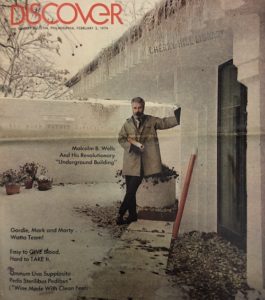
Malcolm B Wells And His Revolutionary “Underground Building” [Photo courtesy of Cherry Hill Library]
Malcolm Wells: One Man’s Crusade To Save The Environment Through Architecture
Malcolm Wells, designer of the former Moorestown Municipal Complex, championed environmentally responsible design and was considered the father of modern earth-sheltered architecture. The exhibit will focus on Wells’ early conventional architecture, his innovative period, and his futuristic ambitions.
“In 1959, at Taliesin West [near Phoenix, Arizona], I stepped out of the hot desert sunlight into this little open-to-the-air theatre, and marveled for a moment or two at Mr. [Frank Lloyd] Wright’s genius, his ability to carry a design through into the tiniest of details, before it struck me that I was suddenly cool and comfortable there under a mantle of earth. It took me only five more years to get the message. In 1964, I suddenly had a brilliant and original idea: buildings should be underground!” -Malcolm Wells
To read the recent Philadelphia Inquirer article, “Rediscovering N.J. architect Malcolm Wells, green building pioneer and mid-century modern master,” click here.
“Malcolm Wells, a bold and forward-thinking architect during the postwar suburban boom in South Jersey, did a mid-career pivot and became a green building pioneer. New exhibits celebrate his work.” -Kevin Riordan, Philadelphia Inquirer
The exhibit will be on view September 29, 2023 – May 14, 2024
2nd & 4th Sundays 1-3pm
Tuesdays 1-4pm
NEW! Watch a slide show of the exhibit on our YouTube Channel.
Celebrate National Underground America Day (founded by Malcolm Wells in 1977) at the iconic office of Malcolm Wells in Cherry Hill, NJ. May 14th. For info and tickets, click here.
Previous Exhibits
19th Century Inscribed Quilts: a Portal to Moorestown History
Our most popular exhibit ever comes to a close June 27th. To schedule a tour for times other than regular open hours, please call us at 856-235-0353, or email moorestownhistory@comcast.net.
NEW! Watch the video!
The stories being told in the new exhibit: Inscribed Quilts: A Portal to Moorestown History at Smith-Cadbury Mansion, paint a vivid picture of life in Moorestown during the mid 1850s: our farms, businesses, homes and families. They illustrate the hard work, determination, devotion and foresight of our residents. A window into the history of Moorestown is opened through a sample of inscribed (signature) quilts from the mid 1800s.
Each signature tells an incredible story of a group of Moorestown residents who were courageous, inventive and daring. Their strength and perseverance helped to shape Burlington County and other parts of the very young United States of America. The signatures on the quilt take us on a journey from Moorestown to upstate New York, to George Washington’s Mt. Vernon in Virginia, down the Ohio River, to New Orleans and back again.
Thank you to Rutgers University Library, Riverton Historical Society, Swarthmore Friends Historical Library, and Woodlawn Friends Meeting House for the use of treasures from their collection. Many thanks to Lee Vetter for filming and producing this video.
Private tours available upon request.
Contact the Historical Society at
moorestownhistory@comcast.net
Smith-Cadbury hours: Tuesdays 1-4pm
2nd & 4th Sunday 1-3pm
Featuring 5 inscribed (signature) quilts that will open a door to life in Moorestown and places near and far through the writings and possessions of the quilts’ signers.
A window into the history of Moorestown is opened through a sample of inscribed (signature) quilts from the mid 1800’s. Each signature tells an incredible story of a group of Moorestown residents who were courageous, inventive and daring. Their strength and perseverance helped to shape Burlington County and other parts of the very young United States of America.
So often when we see a quilt made over 100 years ago we focus on the design, the fabric and the condition of the piece. And while that is essential to appreciating the quilt, the real story is in the signatures. Who were these people, why did they sign the quilt block and what did they contribute to their communities?
The stories being told in the new exhibit will paint a vivid picture of life in Moorestown during the mid 1850’s: our farms, businesses, homes and families. They will illustrate the hard work, determination, devotion and foresight of our residents. Here are just a few of the stories:
Several of the signers left Moorestown in the 1850’s and relocated to Alexandria, Virginia where they purchased part of Mt. Vernon from Nellie Parke Custis, George and Martha Washington’s granddaughter. They took their innovative farming skills to show the landowners of the South that successful farming was possible without slaves.
One signer established a boarding school for girls on Main Street near Stanwick Avenue. Her writings have chronicled events from the hanging of John Brown to a local hanging in Mt. Holly, an 1861 ferry disaster on the Delaware River, a local earthquake and huge chemical fire in Philadelphia.
Another woman who signed the quilt voted before voting privileges were taken away from women in the early 1800’s.
And of course, there is the signer for traveled to Ft. Mifflin in the 1840’s and took a hot air balloon ride to Wilmington, Delaware.
A simple stroke of the pen has opened the door for a fascinating glimpse into Moorestown almost 200 years ago.
Previous Exhibits:
Back to School
Ever wonder what it was like to be a student in the late 19th and early 20th centuries? Visit Smith-Cadbury to “study” school items from the Historical Society’s extensive collection of photographs, textbooks, furniture, and Moorestown High School yearbooks.
Click here to read more about the exhibit in our September Newsletter.
Previous Exhibits:
Moorestown During the First World War
The Historical Society of Moorestown is proud to present “Moorestown During the First World War.” Visitors are invited to tour the exhibit, which has been months in the making and assembled with a painstaking attention to detail. It occupies all three large, downstairs rooms of the Smith-Cadbury Mansion at 12 High Street in Moorestown.
While the war itself lasted from 1914 through most of 1918, America’s direct involvement occurred from 1917-1918. On display in “Moorestown During the First World War” will be a rich and varied collection of artifacts, including military uniforms (shirts, jackets, trousers, and leggings), helmets, weapons, tools, medals, photos, books, letters, artwork, news clippings, and 78 r.p.m. recordings of the day’s popular music, which collectively will tell individual stories of the people of Moorestown in what many once called the “war to end all wars.”
Visitors will get an intimate look at the personal tribulations of Moorestown’s young men, many just graduated from high school, in the heat of battle and as prisoners of war, and the everyday things that worried them and their families back home. Those Moorestown soldiers who gave their lives will be remembered. Also for viewing will be photos, documents, books, and reminiscences covering dissenters– that is, the conscientious objectors among Moorestown’s Quaker youth and the measures taken by the local Quaker community to support them, raise awareness of their plight, and look for other ways these youth could serve their country without engaging in military service. The special challenges of women and African-Americans, at home and abroad, and the impact of the worldwide flu epidemic in 1918-1919 on Moorestown’s soldiers, will be examined. The achievements of a number of Moorestown women serving oversees in the Red Cross or the just-founded American Friends Service Committee will be saluted, and a women’s Red Cross uniform of the time prominently presented.
In a kind of scavenger hunt, current Moorestown High School students will find important information about World War One that they will be able to use in their work assignments. While many artifacts that visitors will see were already part of the Historical Society’s permanent collection, we have received generous, new donations in time for this show, as well as other, loaned items.
Historical Society trustees will be available to answer any questions visitors may have as they walk through the exhibit. We anticipate that this exhibit will be up for the foreseeable future. Admission is free.
–Liz Rosenthal
More on our new exhibit:
Moorestown has an amazing World War I story to tell. To commemorate the Centennial of World War I, our new exhibit entitled “Moorestown During the First World War” features many important aspects of the Great War. This was an opportunity to research, learn and share how New Jersey and especially how Moorestown families contributed to the war effort.
In his book, New Jersey and the Great War: 1914-1919, Richard Connors brings global WWI home to our country, our state, and to Burlington County. For example, the New Jersey National Guard of 1914 had about 4,500 enlisted men and over 300 officers assigned in infantry, cavalry field hospital units, and other functions. “Cantonments” is derived from the French word canton which are military quarters where draftees, volunteers or anyone serving received basic training after being organized into units. 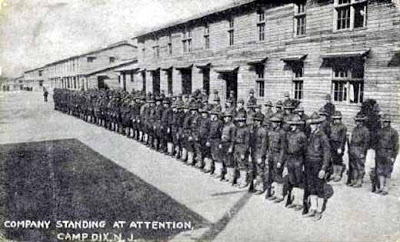
You may be familiar with Fort Dix. Fewer, however, may be familiar with… Camp Dix. In June 1917, Company C, 26th Engineers with the New Jersey National Guard arrived in Wrightstown, Burlington County and constructed Camp Dix (named after War of 1812 and Civil War figure General John Adams Dix). At its peak, 35,000 soldiers were housed at Camp Dix. This included recent immigrants who spoke little English and received language instruction in Camp Dix classrooms. It was also home to the 78th Infantry Division consisting of mostly New Jersey draftees and volunteers. The 78th Division (Camp Dix) was deployed and crossed the Channel to Calais and their Artillery to Le Havre. They sent out aggressive patrols disrupting German action, to seize prisoners and obtain information. ”Enemy artillery fire, falling night and day on all positions with deadly accuracy racked the nerves of the men with continual sight of dead and wounded, rain fell persistently with occasional hours of sunshine, clothing rotted with mud and water, guns and equipment could not be cleaned due to the lack of gun oil.” 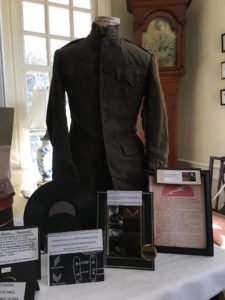 They were ordered to join the Meuse-Argonne offensive and they marched for three days and nights to reach their position. As if not enough, the influenza pandemic raged and claimed victims in the cold wet weeks of early fall. When the war was over, they returned, were cleared and discharged at either Camp Dix or Camp Merritt where many had begun their journey.
They were ordered to join the Meuse-Argonne offensive and they marched for three days and nights to reach their position. As if not enough, the influenza pandemic raged and claimed victims in the cold wet weeks of early fall. When the war was over, they returned, were cleared and discharged at either Camp Dix or Camp Merritt where many had begun their journey.
Our exhibit features this journey through the lives of our Moorestown soldiers and non-combatants who served their country with honor. We show and tell their stories with letters home, uniforms and helmets worn, and an actual piece of a wooden wall found along the Hindenburg Line — it’s really something to see!
It was an honor to learn what we learned and now it’s time to share it with you.
— Mary Berardi
The following events have already occurred:
HISTORICAL SOCIETY SEEKS PROPOSALS FOR HISTORIC BARN
The Historical Society of Moorestown has an opportunity to take possession, by way of a donation from the building’s owner, of the historic barn located behind 37 East Main Street. The plan is for the barn to be removed from its current site to make room for a new commercial building. Therefore the Historical Society is soliciting proposals from Moorestown residents and businesses for the barn’s re-use. Our intention is to transfer ownership of the building to the person(s) or business with the re-use proposal the Historical Society Board of Trustees deems to be the best.
In submitting a proposal to us, please keep the following in mind:
• No proposal to simply re-use the barn materials will be considered. In other words, only proposals calling for the barn to be rebuilt at a different location are eligible.
• The new site for the barn must be located within the Moorestown Township limits.
• Preference will be given to proposals in which the person(s) or business will have the capability in place to take the barn down and reassemble it at the new location.
• Preference will be given to proposals located closest to the current location.
• Preference will be given to proposals where the barn can be viewed by the public.
Proposals can be sent to the Historical Society of Moorestown via email at moorestownhistory@comcast.net, or via mail at 12 High Street, Moorestown, NJ 08057. ALL PROPOSALS ARE DUE BY AUGUST 18, 2017.
Here are some interesting facts that we have gathered about the barn:
*The barn itself is at least 122 years old, as records show it going back to at least 1895.
*It measures 22 feet 3 inches by 46 feet 6 inches, and is two stories tall.
*Alfred H. Burr was the original owner of the property; his house was already there in 1860.
*Burr owned the property as late as 1885.
If you have more information about the history of this barn we’d love to hear from you!
The following events have already occurred:
Our new exhibit, History Rocks! Interpreting the Archaeological Discoveries in Moorestown, is now open and we invite you to visit us and learn about local prehistoric artifacts and the people who used them. The exhibit is open every Tuesday 1-4pm and the second and fourth Sundays 1-3pm.
What you’ll see at the exhibit:
*A prehistory timeline for the prehistoric artifacts on display
*Madeira site fieldwork photographs
*A glossary of archaeological terms
*Treasures from the Collection of Jack Cresson
*Madeira site prehistoric artifact photographs
*Moorestown Archaeological Sites Map: Jack Cresson Collection & Madeira site.
*Display case of Madeira site prehistoric artifacts
*Display case of Madeira site blocked end tubular pipe fragments and whole blocked end tubular pipes on loan from the New Jersey State Museum
*A metate and a mano artifact from the Historical Society’s collection
*The Bartholomew Sutton Collection of artifacts
*An axe head found in Moorestown in 1940
*Collection of prehistoric artifacts of unknown provenance from the Historical Society’s Collection
Our new exhibit, History Rocks! Interpreting the Archaeological Discoveries of Moorestown successfully opened on Sunday, October 16, 2016, at Smith-Cadbury Mansion. The grand opening featured noted local archaeologist Jack Cresson, who, on Smith-Cadbury’s front porch, provided a high-energy, two-hour demonstration to eager onlookers of early Native American toolmaking techniques using a wide array of rock types. Jack Cresson is an influential and much-honored archaeologist who has worked in the field for over 40 years.
On opening day, the History Rocks! exhibit filled Smith-Cadbury to bursting with people of all ages who studied selections from Jack Cresson’s collection of Moorestown artifacts, as well as representative items from the hundreds of prehistoric artifacts retrieved in the Madeira I and II digs which took place in Moorestown four years ago. These artifacts, many of which originated in the Early Woodland Period dating back thousands of years, are supplemented by private collections of artifacts generously donated by other individuals, as well as items from the Historical Society’s own collection.
The exhibit familiarizes visitors with New Jersey archaeology through videos, charts, a timeline, maps, illustrations, and photos, not to mention the three-dimensional artifacts themselves. Among the artifacts on display – frequently spectacular and in a variety of colors, sizes, and stages of perfection or erosion – are: beautiful projectile points (some almost pristine), axe heads, pottery fragments, cobble tools, knives, arrowheads, grinding stones, pestles, 6 Adena-like tubular stone pipe fragments and the prized tubular pipes on loan from the New Jersey State Museum. The pipes are connected to the Adena culture, which originated in what is now Ohio during the Early Woodland Period but spread eastward to modern New Jersey and other nearby regions. They are thought to have been used in burial ceremonies to produce smoke as an offering to the spirits. The artifacts are made of, among other materials, jasper, argillite, flint, fire-cracked rock, and quartz.
In addition to the Madeira site, some of the sections of Moorestown that these artifacts were found include the Young Avenue area, Marter Avenue, the Lockheed Martin area, and the Strawbridge Lake area. A large map of Moorestown highlights the sites where most of the items were excavated. History Rocks! will be on display through June 2017.
Admission is free.
–Liz Rosenthal
In conjunction with our new exhibit, Dr. Greg Lattanzi, Curator for the Bureau of Archaeology and Ethnology at the New Jersey State Museum in Trenton, was the featured speaker at the Annual Meeting of the Historical Society held at the Community House on October 13th. He provided a fascinating overview of the way of life of native peoples and the geological and climatological conditions of pre-historic New Jersey. To read about Dr. Lattanzi’s talk, click here.
The following event has already occurred.
History Rocks: Interpreting the Archaeological Discoveries in Moorestown
Our newest exhibit opens Sunday October 16th!
You might know that the Quakers were the first European people to settle Moorestown in the 1680s. And perhaps you know that the Lenni Lenape Nation called this region home prior to European colonization. But, did you know that people groups before the Lenni Lenape travelled throughout New Jersey and made camps here in Moorestown?
We do not know exactly who these people were but an exciting discovery here in Moorestown suggests that the earliest people who travelled here had contact with the Adena people of Ohio. The Adena promoted a culture that was very particular about burial presentation. They constructed large mounds of earth to mark the placement of their dead and buried personal objects within these mounds.
How do we know that the Adena people had a connection with Moorestown? The exciting discovery made here in Moorestown involves an archaeological dig which took place four years ago. The archaeologists found pieces of silt stone pipe fragments indigenous to the Adena people. Why are these fragments here in Moorestown, New Jersey? What significance did these pipes have to the people who owned them? Possibly, the Adena may have traded the silt stone pipes with other people groups or perhaps the Adena themselves may have briefly camped here. In any case, the discovery is an exciting one! In addition to the pipe fragments, this exhibition features artifacts from the prehistoric past discovered throughout Moorestown. We hope this exhibition will help you to imagine the people who lived here through what they left behind.
Dr. Gregory D. Lattanzi, Curator for the Bureau of Archaeology & Ethnology and New Jersey State Archaeologist at the New Jersey State Museum in Trenton, will speak on this topic at our General Meeting, which is open to the public, on October 13th at 7:30 pm at the Moorestown Community House. Please join us!
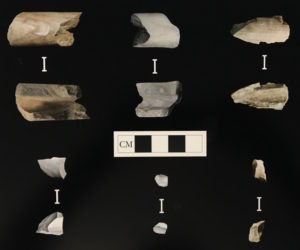
Tubular stone pipe fragments found at the Madeira site in Moorestown.

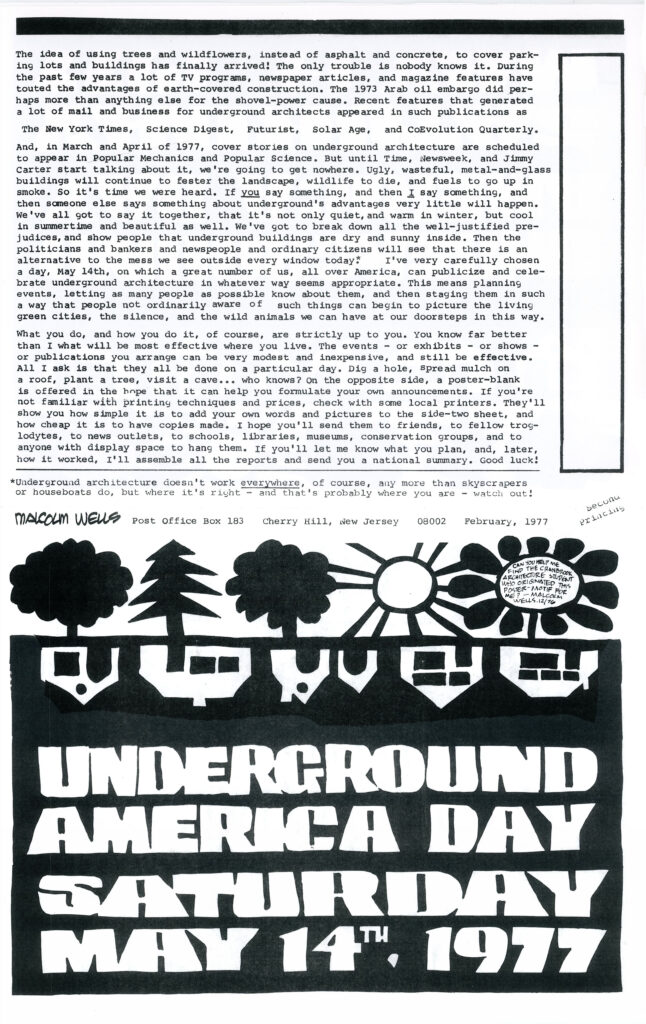
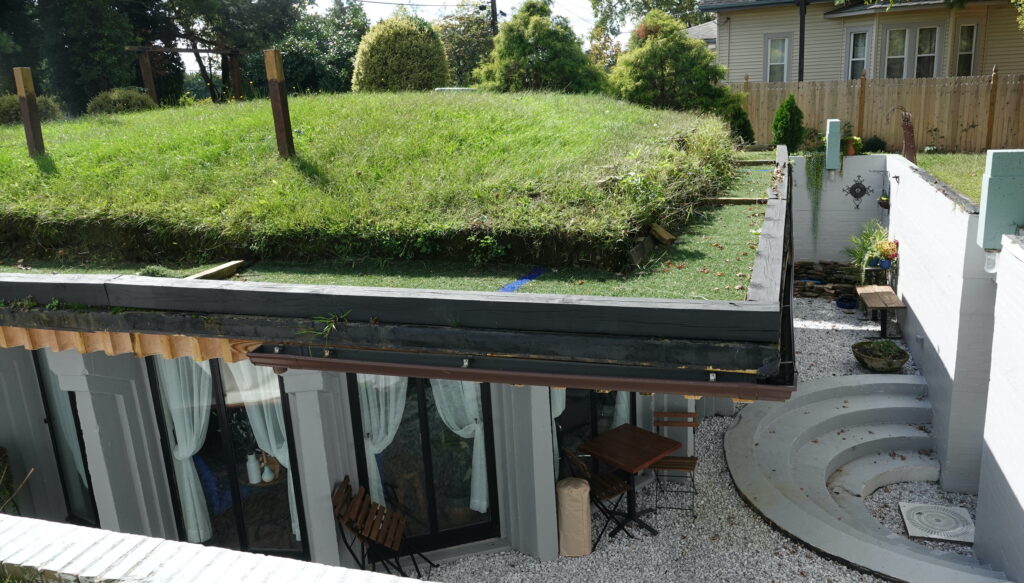
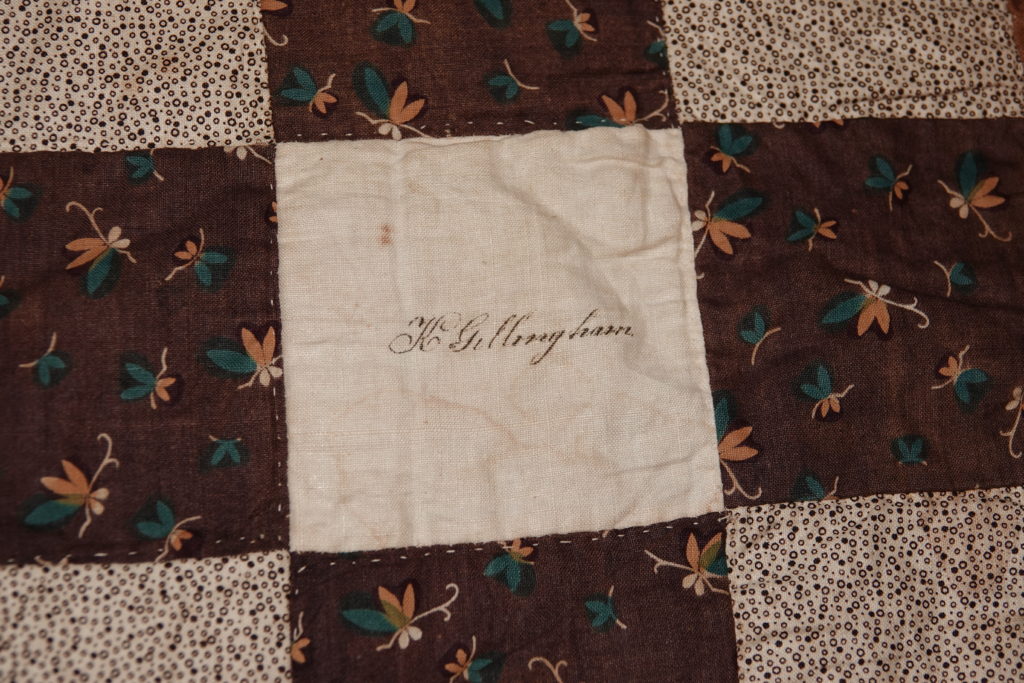
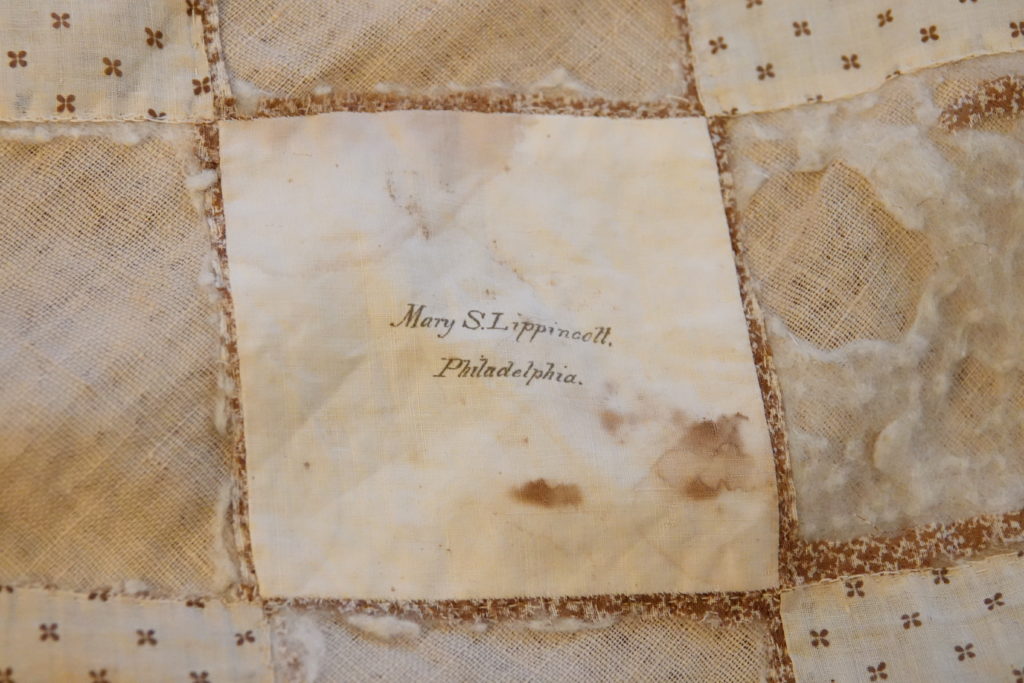
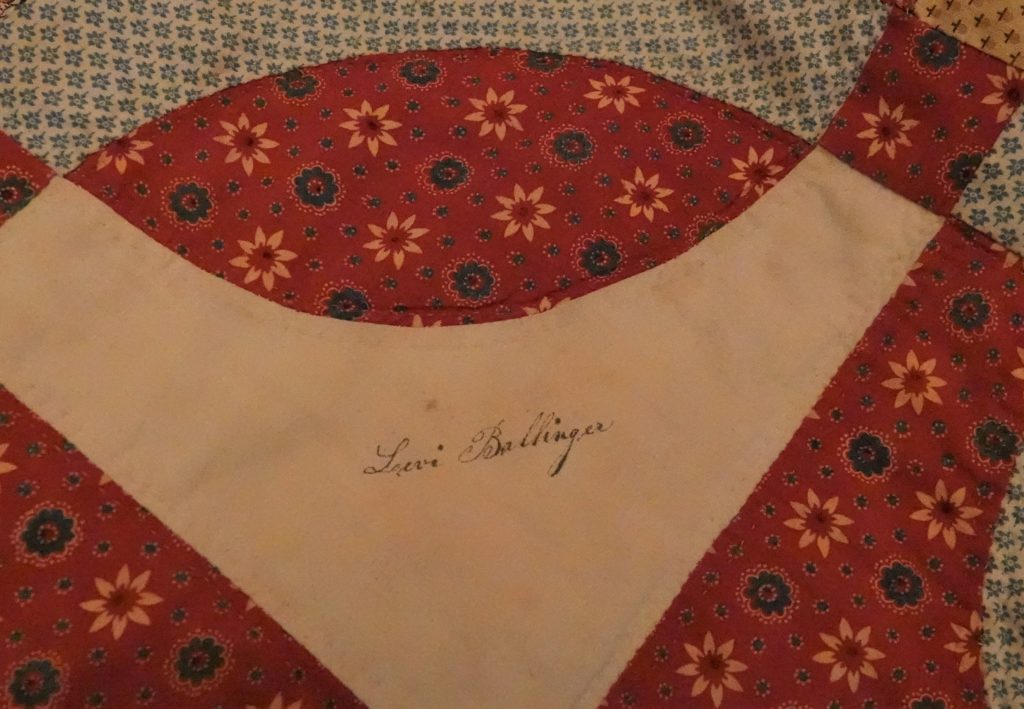
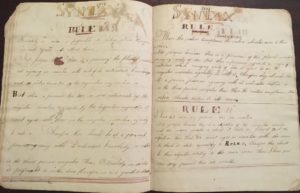

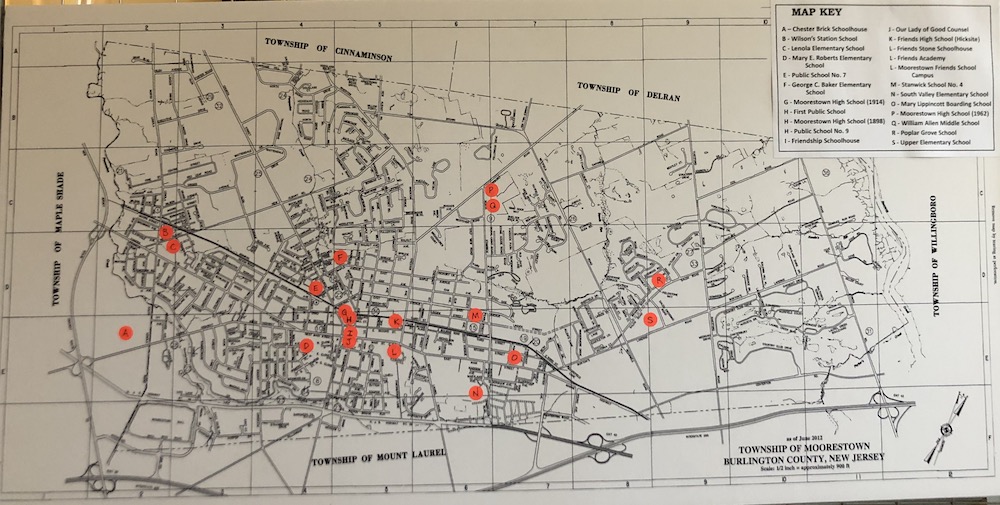
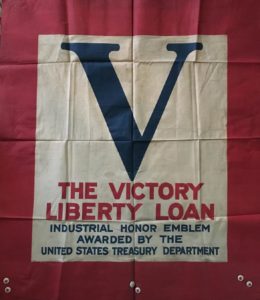
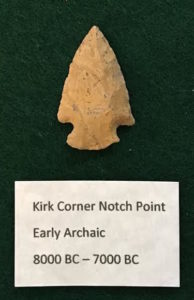
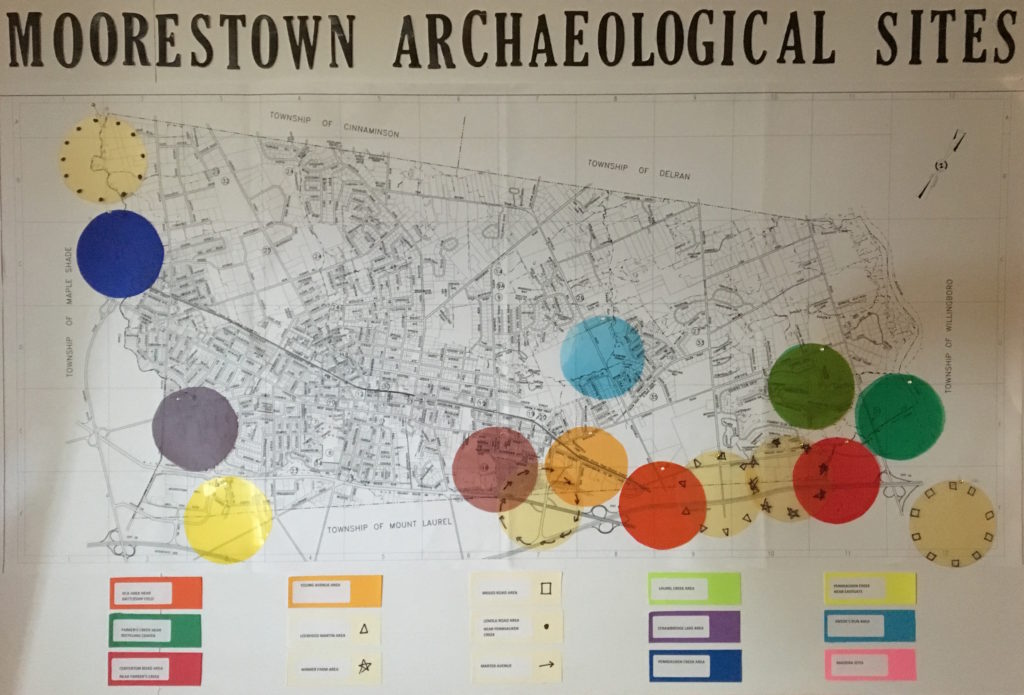
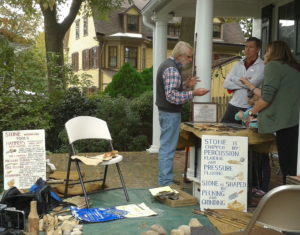
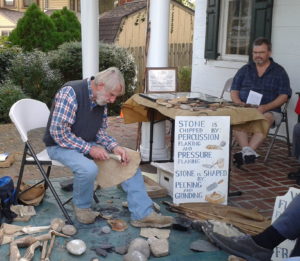

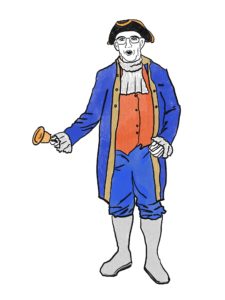




I think the most logical spot would be at the dog park in the East end of town, near the ironstone building.